
Welcome to the biweekly electronic newsletter from Stanford Bio-X for members of the Bio-X Corporate Forum. Please contact Dr. Hanwei Li, the Bio-X Corporate Forum Liaison if you would like to be added or removed from this distribution list, or if you have any questions about Stanford Bio-X or Stanford University.
Highlights
** On October 9, 2013, Bio-X celebrated the 10th Anniversary of the James H. Clark Center, the hub of Bio-X. Check out CLARK CENTER @ 10X as well as the Bio-X Timeline over the last 15 years!!
** Check out the article by Stanford President John Hennessy in the Nov/Dec 2013 issue of the Stanford Magazine on Bio-X and the Clark Center, "A Cauldron of Innovation".
Bio-X Core Programs
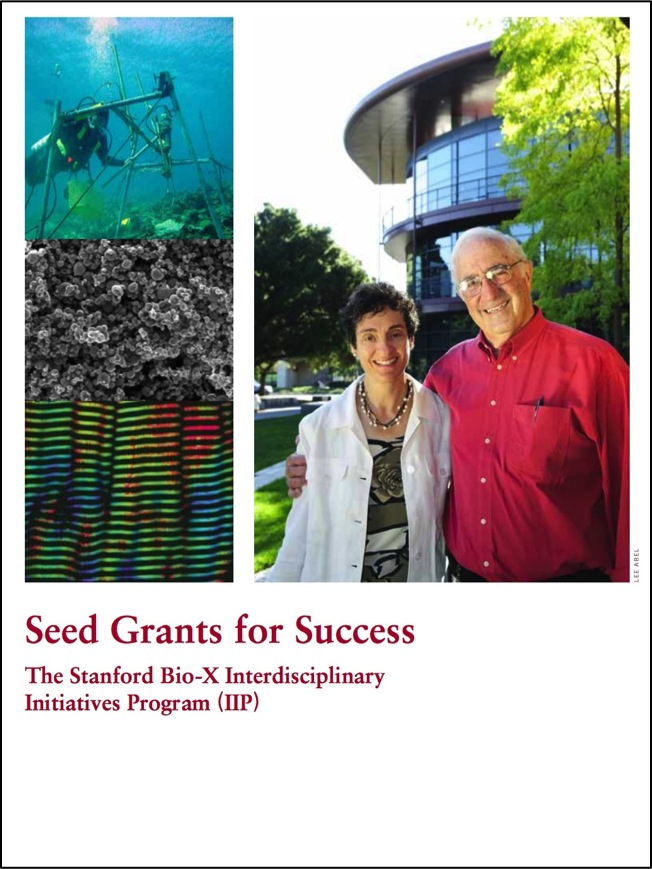 SEED GRANTS FOR SUCCESS - Stanford Bio-X Interdisciplinary Initiatives Program (IIP) SEED GRANTS FOR SUCCESS - Stanford Bio-X Interdisciplinary Initiatives Program (IIP)The Bio-X Interdisciplinary Initiatives Program represents a key Stanford Initiative to address challenges in human health. Currently, the IIP awards approximately $4 million every other year in the form of two-year grants averaging about $200,000 each. From its inception in 2000 through the beginning of the seventh round in 2014, the program has provided critical early-stage funding to 164 different interdisciplinary projects, involving collaborations from over 750 faculty members, and creating over 700 teams from six different Stanford schools. From just the first 6 rounds, the IIP awards have resulted in a 10-fold-plus return on investment, as well as hundreds of publications, dozens of patents filed, and most importantly, the acceleration of scientific discovery and innovation. 2014 is the start of the 7th round of the Bio-X IIP Seed Grants Program, and 22 newly awarded projects were selected from 142 Letters of Intent (LOIs)! This has been the largest number of LOIs that Bio-X has received. Please go here to check out the newly awarded projects. Competition was intense, and the selection criteria included innovation, high-reward, and new interdisciplinary collaborations. (To view the 142 other IIP projects that have been funded from the previous 6 rounds, please click here.) Next week, on Wednesday, August 26, 2015, the next IIP Seed Grant Symposium will be taking place at the Clark Center starting at 1 pm. The agenda is listed below under "EVENTS". Please mark your calendars for this event! |
 Bio-X FELLOWSHIPS Bio-X FELLOWSHIPSEvery year, graduate students and postdoctoral scholars of Bio-X affiliated faculty are highly encouraged to apply for the Bio-X Fellowships, which are awarded to research projects that are interdisciplinary and utilize the technologies of different fields to solve different biological questions. Students are encouraged to work collaboratively with professors of different departments, thus creating cross-disciplinary relationships among the different Stanford schools. Our fellows have conducted exciting research, resulting in publications in high-impact journals and have been offered excellent positions in industry and academia. To date, with the 19 new awardees of 2014, Stanford Bio-X has a total of 173 Fellows. The winners of the 2015 PhD Fellowship program will be announced later on this year. You can view the numerous Fellowship projects that have been awarded over the years as well as oral presentations from previous symposiums here. |
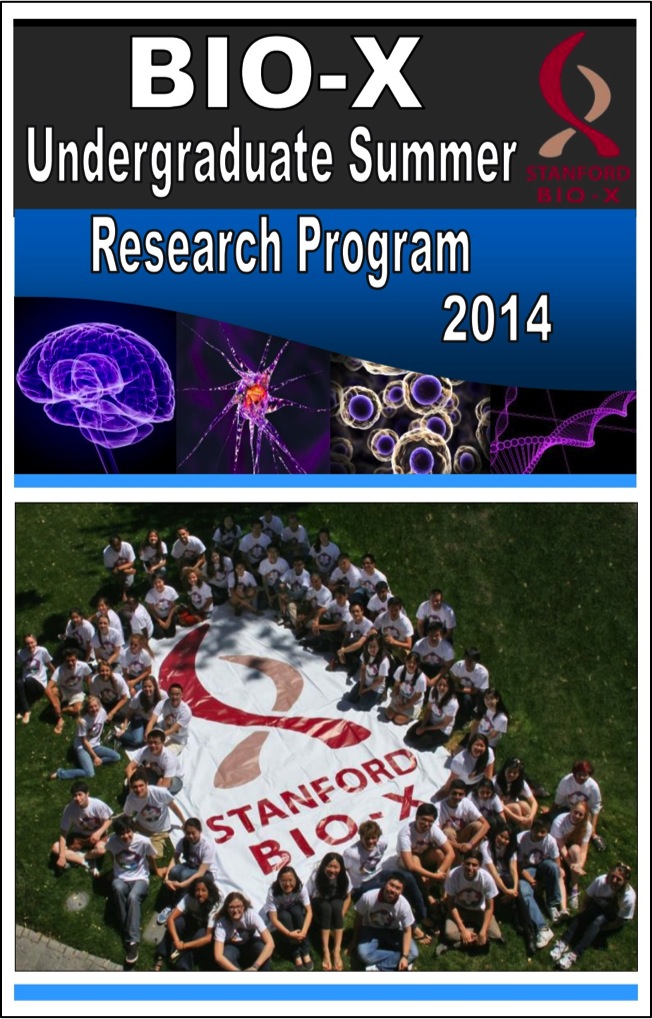 Bio-X UNDERGRADUATE SUMMER RESEARCH PROGRAM Bio-X UNDERGRADUATE SUMMER RESEARCH PROGRAMThe Bio-X Undergraduate Summer Research Program (USRP) supports undergraduate research training through an award designed to support interdisciplinary undergraduate summer research projects. The program is an invaluable opportunity for students to conduct hands-on research, learn how to carry out experiments in the laboratory, and develop the skills to read and analyze scientific literature. This program is eligible to Stanford students who want to work in the labs of Bio-X affiliated faculty. This year, nearly 160 students applied to the program, and 65 students were selected. Therefore, to date, 371 awards have been given to the Stanford undergraduate community to participate in the Bio-X Summer Research Program. The program for 2015 officially started last week. In addition, the Bio-X USRP Faculty Talks have begun, and take place every Wednesday from 12-1 pm until August 26, 2015. Please email Hanwei Li to learn more details and RSVP for any of the faculty talks. Participating undergraduates are also required to present poster presentations on the research that they've conducted during the program. The 2015 posters will be presented during the next Bio-X IIP Seed Grant Symposium on Wednesday, August 26, 2015. Please click here for title lists of past posters that our undergraduates have presented. |
We are cultivating and are highly successful in building meaningful collaborations with numerous corporate colleagues. New collaborations through our core programs are highly encouraged. To learn about how to get involved, please contact Dr. Hanwei Li, or Dr. Heideh Fattaey.
Bio-X also holds symposiums every year that highlight our core programs. The latest one was on February 25, 2015, where over 300 people attended Bio-X's latest Interdisciplinary Initiatives Seed Grants Program Symposium. There were 8 different oral presentations from faculty members who were awarded Bio-X Seed Grants on the progress that they have made with the funding towards their projects, as well as a packed poster session with 100+ research projects presented. THE NEXT BIO-X IIP SEED GRANT SYMPOSIUM IS TAKING PLACE NEXT WEDNESDAY, AUGUST 26, 2015 IN THE CLARK CENTER STARTING AT 1 PM.
If you'd like to learn more about any of the projects that were presented during the entire symposium, please contact Dr. Hanwei Li with your questions.
News

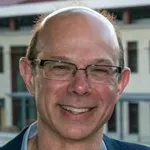
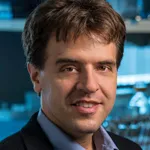 Stanford engineers develop a wireless, fully implantable device to stimulate nerves in mice
Stanford engineers develop a wireless, fully implantable device to stimulate nerves in mice
Bio-X Affiliated Faculty Ada Poon, Scott Delp, and Karl Deisseroth; Bio-X SIGF Fellow Kate Montgomery, and Bio-X Travel Awardee Logan Grosenick
Bio-X IIP Seed Grant and NeuroVentures support
A miniature device that combines optogenetics – using light to control the activity of the brain – with a newly developed technique for wirelessly powering implanted devices is the first fully internal method of delivering optogenetics. The device dramatically expands the scope of research that can be carried out through optogenetics to include experiments involving mice in enclosed spaces or interacting freely with other animals. The work is published in the Aug. 17 edition of Nature Methods. "This is a new way of delivering wireless power for optogenetics," said Ada Poon, an assistant professor of electrical engineering at Stanford. "It's much smaller and the mouse can move around during an experiment." The device can be assembled and reconfigured for different uses in a lab, and the plans for the power source are publicly available. "I think other labs will be able to adapt this for their work," Poon said.

 Researchers design cheaper, faster, more accurate test to identify gene defects in heart patients
Researchers design cheaper, faster, more accurate test to identify gene defects in heart patients
Bio-X Affiliated Faculty Joseph Wu and Bio-X Bowes Fellow Kitchener Wilson
For the subset of heart patients whose illness isn’t caused by a lifetime of cigarettes, trans fats or high glycemic foods, a new genetic test developed at the Stanford University School of Medicine may be able to accurately pinpoint the likely genetic causes of their conditions in just a couple of days. In work that could advance precision health, Kitchener Wilson, MD, PhD, instructor of pathology, and Joseph Wu, MD, PhD, professor of cardiovascular medicine and of radiology, teamed up with a group of genome-sequencing specialists to develop the new technique: a better way to test cardiac patients for any genes that might be causing their problems. Wilson and Wu said that the gold standard of genome sequencing involves thousands of genes, costs $1,000 or more and can take weeks or months to get results. For a patient with a heart condition that’s difficult to diagnose, it makes no sense to sequence the entire 22,000-gene genome, since fewer than 200 genes are known to affect the heart, they said. Moreover, whole-genome sequencing typically contains mistakes, so key mutations might be missed. To meet this challenge, Wilson and Wu’s team designed a streamlined assay, or test, that looks at just the 88 genes known to carry mutations that cause heart problems. Materials for the new test cost about $100, and results are back within three days. Wilson and Wu are first and senior authors, respectively, on a paper describing the assay that was published online Aug. 11 in Circulation Research.
 Elusive liver stem cell identified in mice by researchers
Elusive liver stem cell identified in mice by researchers
Bio-X Affiliated Faculty Roeland Nusse
Researchers at the Stanford University School of Medicine have identified a cell type in the liver of mice that can both self-renew and make new liver cells. The discovery solves a long-standing mystery as to how the organ, which is responsible for many metabolic processes, maintains itself when liver cells, most of which are called hepatocytes, grow old and die. “There’s always been a question as to how the liver replaces dying hepatocytes,” said professor of developmental biology Roel Nusse, PhD. “Most other tissues have a dedicated population of cells that can divide to make a copy of themselves, which we call self-renewal, and can also give rise to the more-specialized cells that make up that tissue. But there never was any evidence for a stem cell in the liver.” Researchers have assumed instead that mature hepatocytes would themselves divide to replace a dying neighbor. However, these cells have an abnormal amount of DNA, which would make cell division extremely difficult. Nusse is the senior author of the work, published Aug. 5 in Nature. He is also a member of the Stanford Cancer Institute, the Stanford Institute for Stem Cell Biology and Regenerative Medicine and a Howard Hughes Medical Institute investigator. First author Bruce Wang, MD, an assistant professor of gastroenterology and hepatology at the University of California-San Francisco, led the research as a visiting scholar in Nusse’s lab.
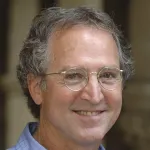 Bacterial community in pregnant women linked to preterm birth, study finds
Bacterial community in pregnant women linked to preterm birth, study finds
Bio-X Affiliated Faculty David Relman
Risk for premature birth is linked to the composition of the vaginal bacterial community in the mother during pregnancy, according to a study from the Stanford University School of Medicine that tracked the body’s microbial communities on a week-by-week basis during pregnancy. A high-diversity pattern in the vaginal bacterial community raised the likelihood of premature birth, and the longer the bacteria followed this pattern, the higher the risk, the study found. The study may also help explain why prematurity risk is elevated in women who have closely spaced pregnancies. A paper describing the research was published online Aug. 17 in the Proceedings of the National Academy of Sciences. Babies born more than three weeks early are considered premature. About 450,000 premature infants are born each year in the United States. Prematurity is the leading cause of newborn deaths. About half of such births occur after spontaneous preterm labor, whose triggers are not well-understood. “We wanted to develop a baseline understanding of what happens to the human microbiome during pregnancy, both in women who deliver healthy, term babies and in those who deliver prematurely,” said the study’s senior author, David Relman, MD, professor of medicine and of microbiology and immunology at Stanford, and chief of infectious diseases at the Veterans Affairs Palo Alto Health Care System.
 Stanford researchers genetically engineer yeast to produce opioids
Stanford researchers genetically engineer yeast to produce opioids
Bio-X Affiliated Faculty Christina Smolke
For thousands of years, people have used yeast to ferment wine, brew beer and leaven bread. Now researchers at Stanford have genetically engineered yeast to make painkilling medicines, a breakthrough that heralds a faster and potentially less expensive way to produce many different types of plant-based medicines. Writing today in Science, the Stanford engineers describe how they reprogrammed the genetic machinery of baker's yeast so that these fast-growing cells could convert sugar into hydrocodone in just three to five days. Hydrocodone and its chemical relatives such as morphine and oxycodone are opioids, members of a family of painkilling drugs sourced from the opium poppy. It can take more than a year to produce a batch of medicine, starting from the farms in Australia, Europe and elsewhere that are licensed to grow opium poppies. Plant material must then be harvested, processed and shipped to pharmaceutical factories in the United States, where the active drug molecules are extracted and refined into medicines. "When we started work a decade ago, many experts thought it would be impossible to engineer yeast to replace the entire farm-to-factory process," said senior author Christina Smolke, an associate professor of bioengineering at Stanford. Now, though the output is small – it would take 4,400 gallons of bioengineered yeast to produce a single dose of pain relief – the experiment proves that bioengineered yeast can make complex plant-based medicines. "This is only the beginning," Smolke said. "The techniques we developed and demonstrate for opioid pain relievers can be adapted to produce many plant-derived compounds to fight cancers, infectious diseases and chronic conditions such as high blood pressure and arthritis."
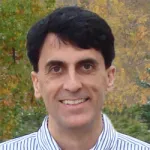 Researchers find mutations that contribute to rare blood cancer
Researchers find mutations that contribute to rare blood cancer
Bio-X Affiliated Faculty Paul Khavari
Researchers at the Stanford University School of Medicine have identified a group of mutations responsible for many cases of a rare immune cell cancer called cutaneous T-cell lymphoma. Identifying the mutations could tip off clinicians to effective treatments for the currently incurable condition. The mutations are found in 15 genes for proteins that work together in a T-cell-survival mechanism. When mutations prevent the mechanism from switching off, the T cells don’t die when they should and actually keep multiplying. The findings were published online Aug. 10 in Nature Genetics. Cutaneous T-cell lymphoma — which manifests as rashes, skin tumors and leukemia — doesn’t respond well to traditional chemotherapy, although a technique known as total skin electron radiation that was developed at Stanford can keep the skin disease at bay. Additionally, a new stem cell transplant therapy, also from Stanford, shows promise for long-term remission for those patients with advanced, high-risk disease. The newly identified cancer role of the proteins involved in the cell-survival mechanism suggests new strategies for fighting the disease: Researchers can look for drugs to counter the malfunctioning proteins resulting from the mutations.
 Brain scans better forecast math learning in kids than do skill tests, study finds
Brain scans better forecast math learning in kids than do skill tests, study finds
Bio-X Affiliated Faculty Vinod Menon
Brain scans from 8-year-old children can predict gains in their mathematical ability over the next six years, according to a new study from the Stanford University School of Medicine. The research tracked 43 children longitudinally for six years, starting at age 8, and showed that while brain characteristics strongly indicated which children would be the best math learners over the following six years, the children’s performance on math, reading, IQ and memory tests at age 8 did not. The study, published online Aug. 18 in The Journal of Neuroscience, moves scientists closer to their goal of helping children who struggle to acquire math skills. “We can identify brain systems that support children’s math skill development over six years in childhood and early adolescence,” said the study’s lead author, Tanya Evans, PhD, postdoctoral scholar in psychiatry and behavioral sciences. “A long-term goal of this research is to identify children who might benefit most from targeted math intervention at an early age,” said senior author Vinod Menon, PhD, professor of psychiatry and behavioral sciences. “Mathematical skills are crucial in our increasingly technological society, and our new data show which brain features forecast future growth in math abilities.”
Stanford researchers unveil virtual reality headset that reduces eye fatigue, nausea
Electrical Engineering Faculty Gordon Wetzstein
Try on any virtual reality headset, and within a few minutes the sense of wonder might wear off and leave you with a headache or a topsy-turvy stomach. Computational imaging experts say that's because current virtual reality headsets don't simulate natural 3D images. Now researchers in the Stanford Computational Imaging Group have created a prototype for a next-generation virtual reality headset that uses light-field technology to create a natural, comfortable 3D viewing experience. With help from NVIDIA Corp., their findings will be presented and demonstrated Aug. 9-13 in Los Angeles at SIGGRAPH 2015, a conference that focuses on computer graphics and interactive techniques. In current "flat" stereoscopic virtual reality headsets, each eye sees only one image. Depth of field is also limited as the eye is forced to focus on only a single plane. In the real world, we see slightly different perspectives of the same 3D scene at different positions of our eye's pupil, said Gordon Wetzstein, an assistant professor of electrical engineering at Stanford. We also constantly focus on different depths.
Events
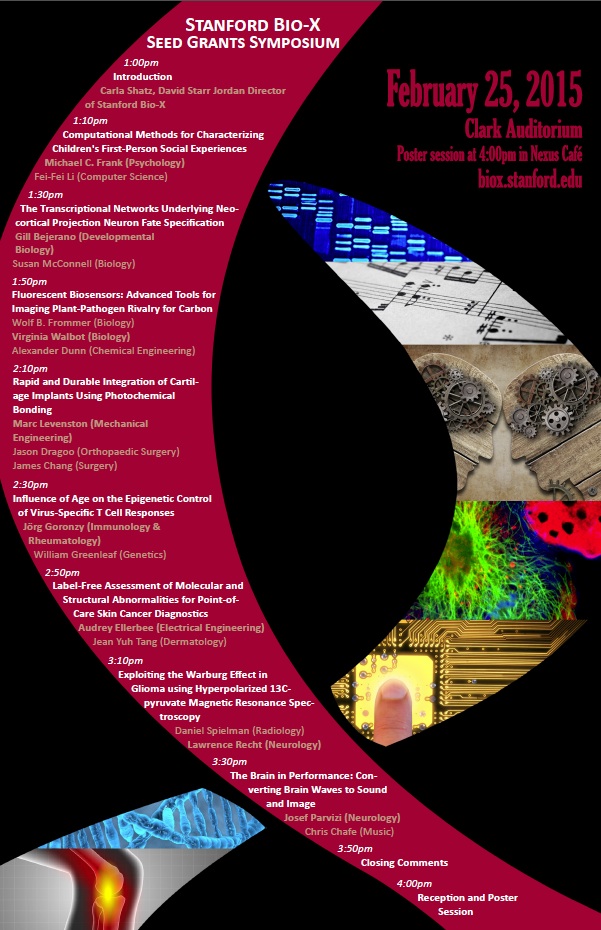 Bio-X Interdisciplinary Initiatives Symposium Bio-X Interdisciplinary Initiatives SymposiumWednesday, August 26, 2015 Clark Center Auditorium Bio-X Interdisciplinary Initiatives Program grant awardees will give fifteen-minute presentations at the symposium. A poster session will be held during a post symposium reception, where students involved in interdisciplinary research will present their work. 1:00pm Introduction CARLA SHATZ - David Starr Jordan Director of Stanford Bio-X 1:10pm Adaptation of a Miniature Microscope for the Noninvasive In Vivo Detection of Rare Circulating Tumor Cells in the Vasculature CHRISTOPHER CONTAG (Pediatrics), Michael Clarke (Oncology), Olav Solgaard (Electrical Engineering) 1:30pm Prediction of Therapeutic Efficacy of Targeted Oncogene Inactivation via PET Imaging Using a Novel Smart Apoptosis Probe ([18F]CAIP) DEAN FELSHER (Oncology), Jianghong Rao (Radiology), Frederick Chin (Radiology), David Paik (Radiology) 1:50pm Real Time Biology Cloud Experiments at Scale: Technology Development and Integration in Education INGMAR RIEDEL-KRUSE (Bioengineering), Paulo Blikstein (Education) 2:10pm Building Genetic Tools to Engineer Cyanobacteria James Swartz (Chemical Engineering), JULIE THERIOT (Biochemistry) 2:30pm Novel Approaches to Antiviral Therapy SHIRIT EINAV (Medicine), Stephen Quake (Bioengineering) 2:50pm The Physics of Healthy Embryo Development DAVID CAMARILLO (Bioengineering), Renee Reijo Pera (Obstetrics & Gynecology), Barry Behr (Obstetrics & Gynecology) 3:10pm Illuminating the Neural Basis of Risky Choice BRIAN KNUTSON (Psychology), Karl Deisseroth (Bioengineering) 3:30pm Developing Targeted Drug Therapies for Brain Tumors JENNIFER COCHRAN (Bioengineering), Michelle Monje (Neurology) 3:50pm Closing comments 4:00pm Reception and poster session |
Resources
| Stanford University |
| Stanford Bio-X |
| Bio-X Seed Grants The Stanford Bio-X Interdisciplinary Initiatives Program (IIP) provides seed funding for high-risk, high-reward, collaborative projects across the university, and have been highly successful in fostering transformative research. |
| Office of Technology and Licensing "Techfinder" Search the OTL Technology Portal to find technologies available for licensing from Stanford. |
| Stanford Center for Professional Development - Take advantage of your FREE membership! - Take online graduate courses in engineering, leadership and management, bioscience, and more. - Register for free webinars and seminars, and gets discounts on courses. |
| Stanford Biodesign Video Tutorials on how FDA approves medical devices A series of video briefs recently produced by the Stanford Biodesign Program teaches innovators how to get a medical device approved for use in the United States. This free, online library of 60 videos provides detailed information on the Food and Drug Administration regulatory process, short case studies and advice on interacting with the FDA. |
To learn more about Stanford Bio-X or Stanford University, please contact Dr. Hanwei Li, the Bio-X Corporate Forum Liaison, at 650-725-1523 or lhanwei1@stanford.edu, or Dr. Heideh Fattaey, the Executive Director of Bio-X Operations and Programs, at 650-799-1608 or hfattaey@stanford.edu.

